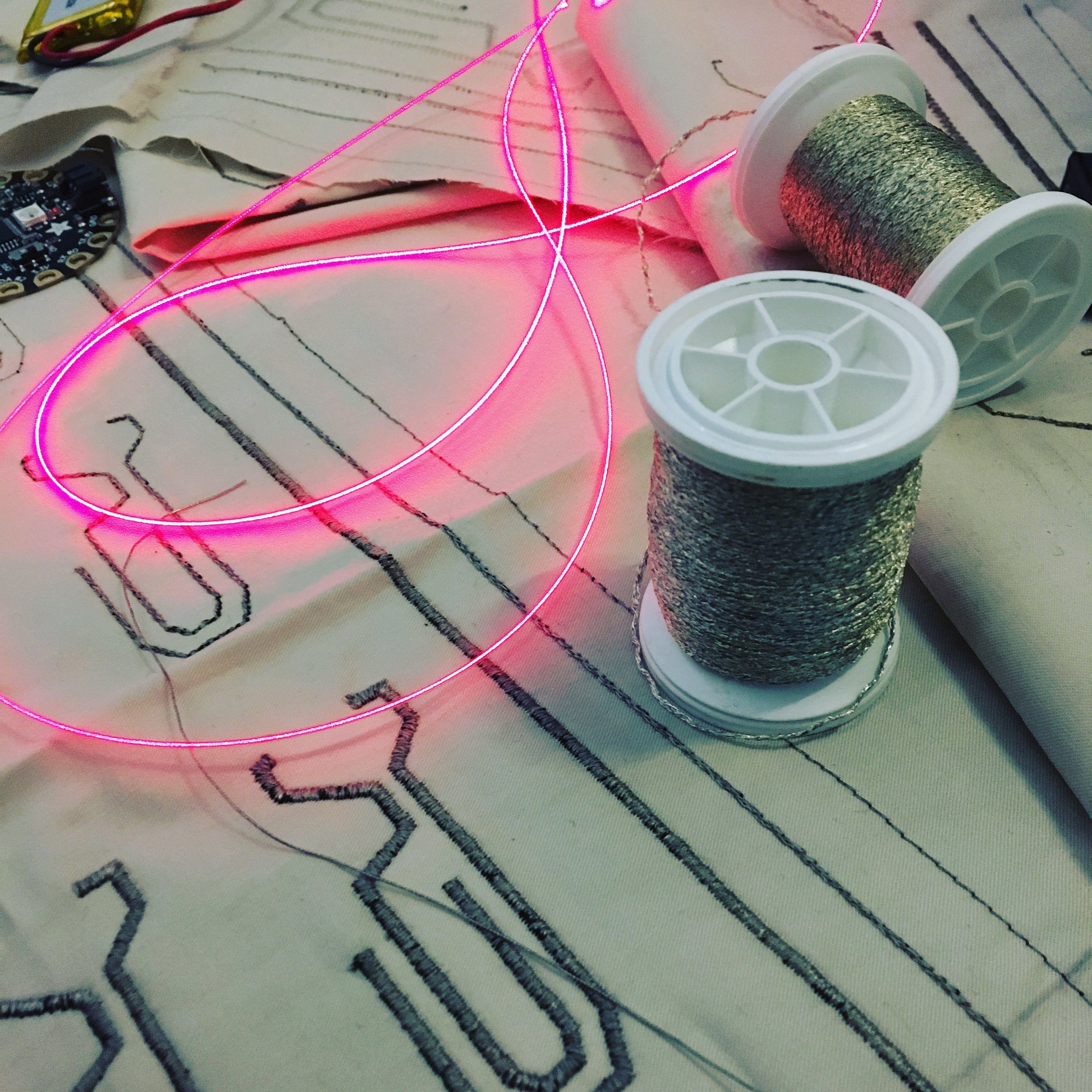From the Toolbox: Conductive Materials
Here at Loomia, we love using conductive materials in our workshop. Typically, we use conductive thread and tape when experimenting with circuits. They are handy items to have in the toolbox, and are super easy to use. For this reason, we highly recommend working with conductive materials if you are new to prototyping with electronics. There are four main types of conductive materials available for sale to everyday makers: conductive fabric, conductive paint, conductive thread, and conductive tape. And, each type is used and applied differently. Read on to learn more, and hopefully get inspired to make your own creations using conductive materials!
CONDUCTIVE FABRIC
Image: Sparkfun
Conductive fabrics are non-woven materials that can be used for electromagnetic and resistive heating applications. They feel like felt and are wire-free; making them lightweight and flexible. You can even puncture or cut the fabric, and it still functions.
Conductive fabrics could be considered e-textiles in that they possess several of the qualities e-textiles do. They consist of conductive elements, are textile-based, and can emit and provide sensing capabilities.
The applications for this fabric are wide ranging; from medical wearables to aerospace interiors. One of our favorite projects to feature conductive fabric is a homemade button. You can find a tutorial for making your own button component here. Or, buy a ready-made Loomia Single Backlit Button on Sparkfun.
Can be: Sewn, woven, cut, braided, or bonded with adhesive
CONDUCTIVE PAINT
Image: Adafruit Industries
Conductive paint, also called ‘electric paint,’ is made of copper, silver, or nickel. Conductive paint and conductive ink differ in that the paint sits on the surface of a material, whereas ink penetrates the surface. While the origins of conductive paint are murky, the invention became widely known when four graduates from the Royal College of Art in London created “Bare Paint.” Bare Paint was the product of an experiment conducted back in 2009 by Isabel Lizardi, Matt Johnson, Bibi Nelson, and Becky Pilditch. The group was initially interested in how electronics could be applied to the skin, but quickly realized they would be best utilized in the form of a coating or paint. From this point forward, a company was born.
While the Bare Conductive paint is certainly safe, it can no longer be applied to the skin. Today, Bare Conductive paint can be used to create circuits for wearables, electronic devices, and prototypes.
Learn more about Bare Conductive and shop their products.
Can be used on: paper, plastic, wood, cardboard, or glass surfaces
CONDUCTIVE THREAD
Conductive thread can be dated as far back as the Elizabethan era. However, they were more commonly used as embellishment for garments and not for conducting electricity. Conductive thread typically comes in silver, copper, and stainless-steel varieties, and is used to create circuits. The base of the thread is nylon, which is then coated with a metal of choice. Unless you are talking about stainless steel thread, which is made entirely of stainless steel. These threads are sewable, and can be used along with electronic components such as LEDs and circuit boards.
The great thing about conductive thread is that it can be sewn into fabric, sewn directly onto the surface of fabric for embroidered circuits, or soldered to create connections. Adafruit has tons of fun projects using conductive thread that we highly recommend checking out!
Can be used: by hand or in an industrial sewing machine
CONDUCTIVE TAPE
Conductive tape comes in several forms: silver, nickel, copper, and graphite. They are typically used for insulating electric wires and cable wrapping. However, they can also be used to make conductive traces for paper circuits. Copper tape, for example, is solderable and has greater strength than conductive paint and ink.
Copper adhesive tape can conduct electricity on both the top and bottom. It is important to note that copper tape can cause a nasty cut, so be careful when handling.
One of our favorite projects using conductive tape is Conductive Greeting Cards. There is a tutorial on Instructables, just in time for the holidays! Make a glitzy Christmas card for family members and friends, and watch their faces beam with delight.
Can be used on: fabric, plastic, paper, or any flat surface
The best thing you can do when using new materials is to tinker around! Combine conductive thread and tape or conductive paint and fabric, and see what magic can be made. There are plenty of helpful guides to help you work with these materials, and our inbox is always open to answer any of your questions. Just email mary@loomia.com and we will get back to you as soon as possible.
FOR CONTINUED INSPIRATION:
A Buyer’s Guide to Prototyping at Home




